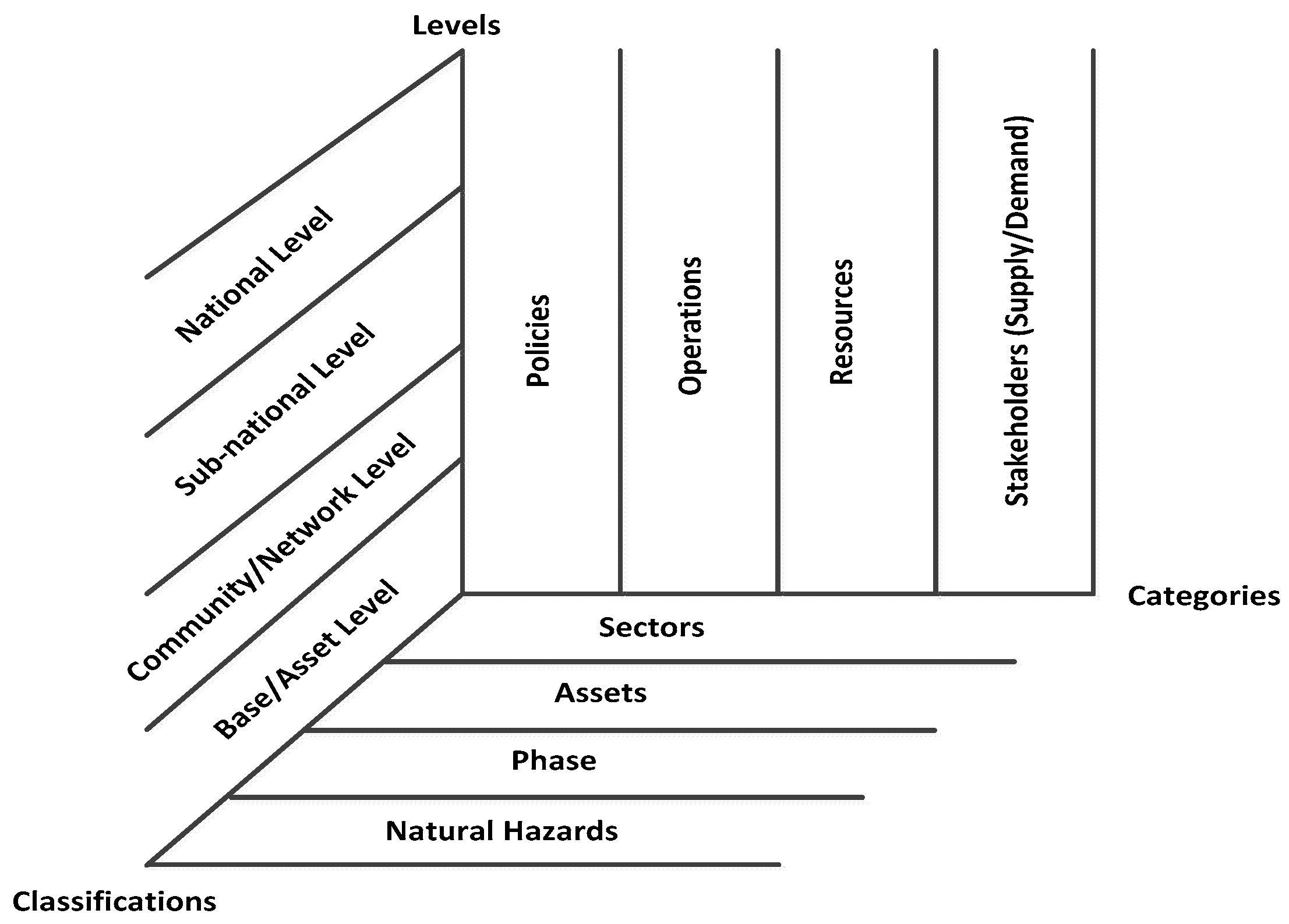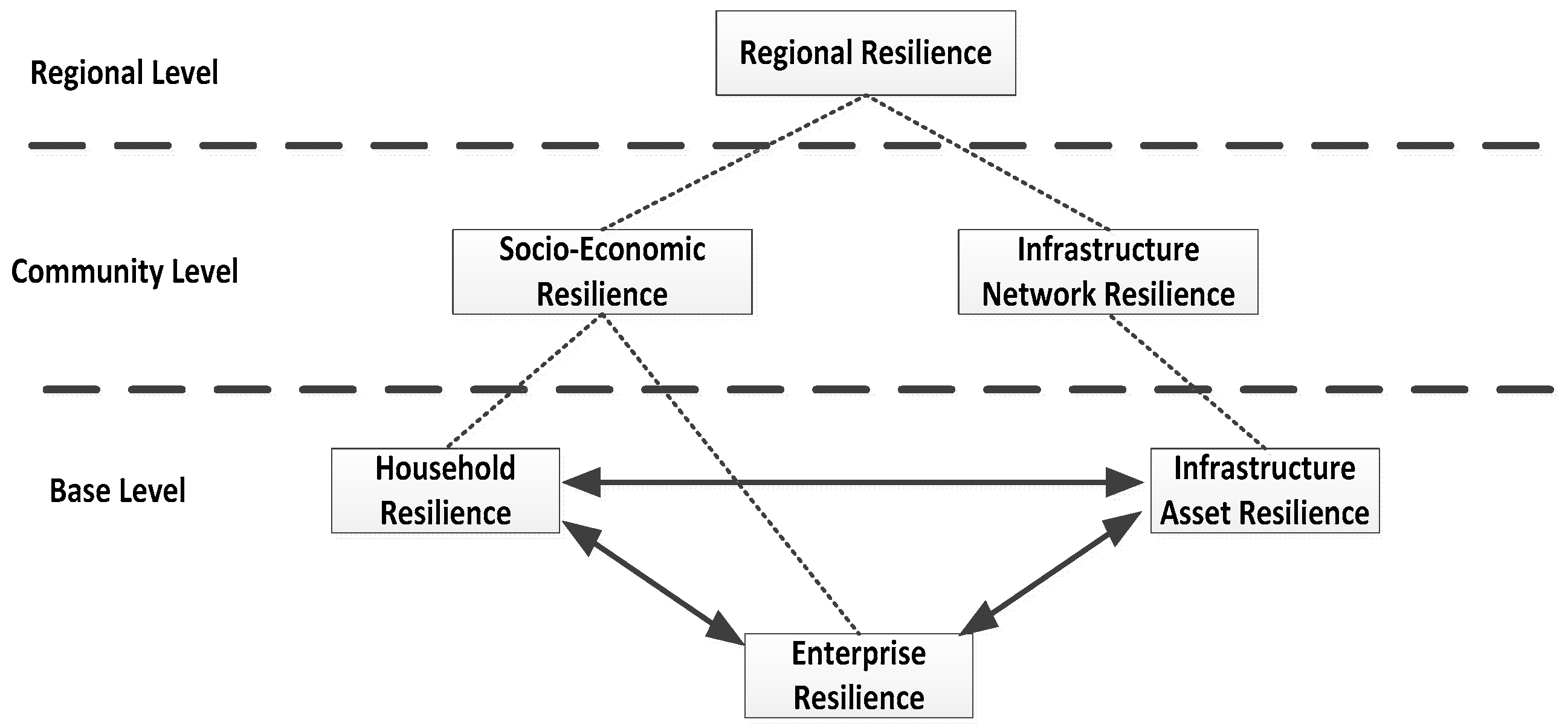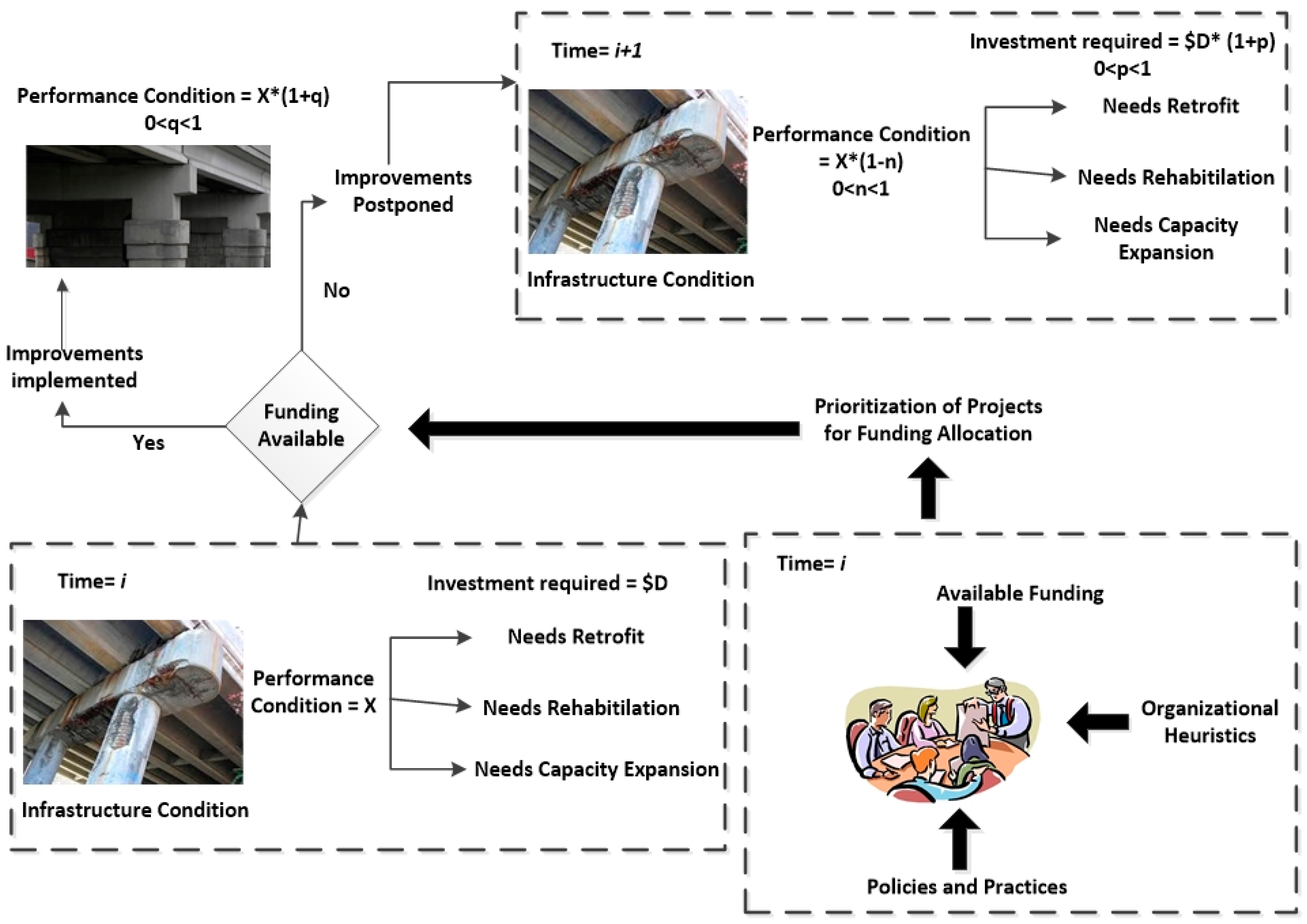A System-of-Systems Approach for Integrated Resilience Assessment in Highway Transportation Infrastructure Investment
Abstract
:1. Introduction
1.1. System-of-System Approach
1.2. Resilience in Highway Transportation Infrastructure
2. Data Collection and Analysis
2.1. Status Quo
2.1.1. Preparedness
2.1.2. Mitigation
2.1.3. Response
2.1.4. Recovery
2.2. Drivers
2.3. Barriers
3. Strategies for Improvement
3.1. Expanding the Available Funding for Retrofit and Betterment Projects
3.2. Use of Risk and Vulnerability Assessment in Conjunction with Resilience Indices
3.3. Integration of the Efforts across Different Players and Units
4. Conclusions
Conflicts of Interest
References
- Hewitt, K. (Ed.) Interpretations of Calamity; Allen and Unwin: Boston, MA, USA, 1983. [Google Scholar]
- White, G.F. Human Adjustment to Floods; The University of Chicago: Chicago, IL, USA, 1945. [Google Scholar]
- Holling, C.S. Resilience and stability of ecological systems. Annu. Rev. Ecol. Syst. 1973, 4, 1–23. [Google Scholar] [CrossRef]
- Manyena, S.B.; Fordham, M.; Collins, A. Disaster resilience and children: Managing food security in Zimbabwe’s Binga district. Child. Youth Environ. 2008, 18, 303–331. [Google Scholar]
- Peek, L. Children and disasters: Understanding vulnerability, developing capacities, and promoting resilience—An Introduction. Child. Youth Environ. 2008, 18, 1–29. [Google Scholar]
- Ronan, K.R.; Crellin, K.; Johnston, D.M.; Becker, J.; Finnis, K.; Paton, D. Promoting child and family resilience to disasters: Effects, interventions and prevention effectiveness. Child. Youth Environ. 2008, 18, 332–353. [Google Scholar]
- Berke, P.R.; Campanella, T.J. Planning for Post-disaster Resiliency. Ann. Am. Acad. Political Soc. Sci. 2006, 604, 192–207. [Google Scholar] [CrossRef]
- Campanela, T.J. Urban Resilience and the Recovery of New Orleans. J. Am. Plan. Assoc. 2006, 72, 141–146. [Google Scholar] [CrossRef]
- Vale, L.; Campanella, T.J. (Eds.) The Resilient City: How Modern Cities Recover from Disaster; Oxford University Press: New York, NY, USA, 2005. [Google Scholar]
- Mileti, D.S. Disasters by Design: A Reassessment of Natural Hazards in the United States; National Academies Press: Washington, DC, USA, 1999. [Google Scholar]
- Mayunga, J.S. Understanding and applying the concept of community disaster resilience: A capital-based approach. In Proceedings of the Summer Academy for Social Vulnerability and Resilience Building, Munich, Germany, 22–28 July 2007; pp. 1–16. [Google Scholar]
- Cutter, S.L.; Burton, C.G.; Emrich, C.T. Disaster resilience indicators for benchmarking baseline conditions. J. Homel. Secur. Emerg. Manag. 2010, 7. [Google Scholar] [CrossRef]
- Batouli, M.; Mostafav, A. Service and performance adjusted life cycle assessment: A methodology for dynamic assessment of environmental impacts in infrastructure systems. Sustain. Resil. Infrastruct. 2017, 2, 117–135. [Google Scholar] [CrossRef]
- Azevedo de Azevedo, B.; Mostafavi, A. Resilience of Infrastructure Systems to Sea-Level Rise in Coastal Areas: Impacts, Adaptation Measures, and Implementation Challenges. Sustainability 2016, 8, 1115. [Google Scholar] [CrossRef]
- Faturechi, R.; Miller-Hooks, E. A mathematical approach for quantifying and optimizing protective actions for civil infrastructure systems. Comput. Aided Civ. Infrastruct. Eng. 2014, 29, 572–589. [Google Scholar]
- Rinaldi, S.M.; Peerenboom, J.P.; Kelly, T.K. Identifying, understanding, and analyzing critical infrastructure interdependencies. IEEE Control Syst. 2001, 21, 11–25. [Google Scholar] [CrossRef]
- O’Rourke, T.D. Critical infrastructure, interdependencies, and resilience. In The Bridge; National Academy of Engineering-Spring: Washington, DC, USA, 2007; pp. 22–29. [Google Scholar]
- Reed, D.A.; Kapur, K.C.; Christie, R.D. Methodology for assessing the resilience of networked infrastructure. IEEE Syst. J. 2009, 3, 174–180. [Google Scholar] [CrossRef]
- DeLaurentis, D.A. A taxonomy-based perspective for systems of systems design methods. In Proceedings of the 2005 IEEE International Conference on Systems, Man and Cybernetics, Waikoloa, HI, USA, 12 October 2005; Volume 1, pp. 86–91. [Google Scholar]
- Maier, M.W. Architecting principles for systems-of-systems. Syst. Eng. 1998, 1, 267–284. [Google Scholar] [CrossRef]
- Zhu, J.; Mostafavi, A. Integrated Performance Assessment in Complex Engineering Projects Using a Systems-of-Systems Approach. IEEE Syst. J. 2017, PP, 1–12. [Google Scholar] [CrossRef]
- Mostafavi, A.; Abraham, D.M.; DeLaurentis, D.; Sinfield, J. Exploring the dimensions of systems of innovation analysis: A system of systems approach. IEEE Syst. J. 2011, 5, 256–265. [Google Scholar] [CrossRef]
- Mostafavi, A.; Abraham, D.M.; Lee, J. System-of-Systems Approach for Assessment of Financial Innovations in Infrastructure. J. Build. Environ. Proj. Asset Manag. 2012, 2, 250–265. [Google Scholar] [CrossRef]
- Mostafavi, A.; Abraham, D.; DeLaurentis, D.; Sinfield, J.; Kandil, A.; Queiroz, C. Agent-Based Simulation Model for Assessment of Financing Scenarios in Highway Transportation Infrastructure Systems. J. Comput. Civ. Eng. 2015, 30. [Google Scholar] [CrossRef]
- Meyer, M.; Flood, M.; Keller, J.; Lennon, J.; McVoy, J.; Dorney, C.; Leonard, K.; Hyman, R.; Smith, J. Climate Change, Extreme Weather Events and the Highway System: A Practitioner’s Guide; National Cooperative Highway Program, Transportation Research Board: Washington, DC, USA, 2014. [Google Scholar]
- Meyer, M.; Rowan, E.; Savonis, M.; Choate, A.; ICF International. Integrating Extreme Event Risk in Transportation Asset Management; American Association of State Highway and Transportation Officials: Washington, DC, USA, 2013. [Google Scholar]
- Federal Highway Administration (FHWA). Risk-Based Transportation Asset Management: Building Resilience into Transportation Infrastructure. 2013. Available online: http://www.fhwa.dot.gov/asset/pubs/hif13018.pdf (accessed on 4 April 2014).
- Tierney, K.; Bruneau, M. Conceptualizing and measuring resilience: A key to disaster loss reduction. TR News 2007, 17, 14–15. [Google Scholar]
- Mostafavi, A.; Inman, A. Exploratory analysis of the pathway towards operationalizing resilience in transportation infrastructure management. Built Environ. Proj. Asset Manag. 2016, 6, 106–118. [Google Scholar] [CrossRef]
- Mostafavi, A.; Abraham, D.M. Resilience-Based Planning in Civil Infrastructure using System-of-Systems Analysis. In Proceedings of the ASCE Construction Research Congress 2014, Atlanta, GA, USA, 19–21 May 2014. [Google Scholar]





| Dimensions of SoS Approach | Components of Analysis | Assessment of Resilience in Highway Transportation Infrastructure |
|---|---|---|
| Classifications | Sectors | Highway transportation |
| Assets | Roads, highways, and bridges | |
| Phase | Preparedness, mitigation, response, and recovery | |
| Natural hazards | Storm, hurricane, and flood | |
| Categories | Resources | Capital and human resources |
| Stakeholders | Public infrastructure and disaster management agencies, asset owners and operators, private entities, MPOs, and engineering and contracting companies | |
| Operations | Budget and resource allocation and prioritization of rehabilitation and maintenance activities (pre- and post-disaster) | |
| Policies | Policies pertaining to operation and management of transportation infrastructure | |
| Levels | Base/Asset | Asset resilience |
| Network | Network resilience | |
| Sub-national | Regional resilience |
| Case Study | Agency | Number of Participants |
|---|---|---|
| Colorado Flood | Local Department of Public Works (Adams County) | 1 |
| State Transportation Agency | 2 | |
| Federal transportation Agency | 2 | |
| Consulting Firm | 3 | |
| Hurricane Sandy | State Transportation Agency | 7 |
| Local Disaster Management | 1 |
© 2017 by the author. Licensee MDPI, Basel, Switzerland. This article is an open access article distributed under the terms and conditions of the Creative Commons Attribution (CC BY) license (http://creativecommons.org/licenses/by/4.0/).
Share and Cite
Mostafavi, A. A System-of-Systems Approach for Integrated Resilience Assessment in Highway Transportation Infrastructure Investment. Infrastructures 2017, 2, 22. https://doi.org/10.3390/infrastructures2040022
Mostafavi A. A System-of-Systems Approach for Integrated Resilience Assessment in Highway Transportation Infrastructure Investment. Infrastructures. 2017; 2(4):22. https://doi.org/10.3390/infrastructures2040022
Chicago/Turabian StyleMostafavi, Ali. 2017. "A System-of-Systems Approach for Integrated Resilience Assessment in Highway Transportation Infrastructure Investment" Infrastructures 2, no. 4: 22. https://doi.org/10.3390/infrastructures2040022




